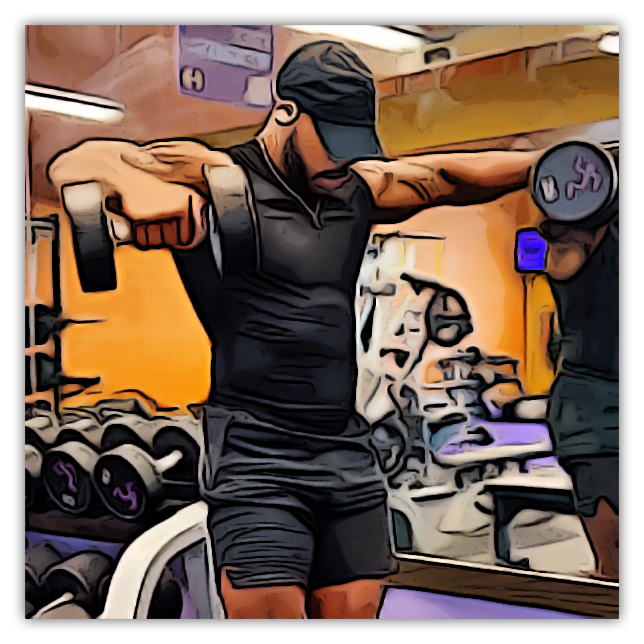Why You Don't Need High Reps To Burn Fat
Weightlifting myths plague us even this far into the new millennium. High reps for fat loss is no exception. I still happen upon this way of thought from time to time, usually in passing.
“I want to lose some weight, I know I should be doing higher reps, but I like to go heavy.”
This my friend is a myth. I see how one could arrive at this conclusion, but let’s clear the air.
Why You Don't Need High Reps To Burn Fat
Why Low Weight, High Reps Won’t Burn More Fat
An old school bodybuilding practice is to switch your program to exclusively high reps when it’s time to focus on fat loss AKA start to cut.
By high reps I mean anything above 15 in a given set. It was believed doing a higher number of repetitions would give one more definition, which is the result of loss fat and retained muscle mass.
I can see how plenty would put two together and come out with an answer as such, especially when they saw results. On its face, do the motion more times you’d burn more calories right? Not if those extra reps required less effort.
When you increase the number of reps you have no choice, but to lift a lighter load than what you’d have the ability to move with lower reps.
So these fat loss results were the remains of a calorie deficit, not because they’d do super high rep training. Moving something lighter more times won’t give you an advantage in the fat loss department, it’s just a different way to stimulate your muscles.
The benefits of resistance training is a continuum where low reps and heavier weight have a similar calorie burning impact to high reps with a lighter load [1].
Within this continuum your rep scheme is specialized. 1-5 reps is more strength based, 6-15 is your hypertrophic partner, and 15+ is great for endurance.
Note: specialized isn’t to imply only. Every rep range will develop some strength, some hypertrophy, and some stamina, yet each scheme has its niche.
Benefits Of Low Weight, High Rep Resistance Training
High reps may not be better for fat loss and creating definition, but they are another tool for your kit. Take note of the benefits to low weight, high reps in your program:
Better pumps, which help create fuller muscles
Lessened injury risk
Easier on joints
Great start for new lifters to develop correct motor patterns
Optimize endurance
Good way to work on form
Each rep provides another chance to enhance mind muscle connection
Can be a method to provide central nervous system relief
Induces hypertrophy and strength improvements
Increases blood flow
Bolsters vascularity
Similar to cardio in that it burns more calories in the moment
Note: a drawback of high reps is how time consuming they are, especially if you want to adhere to that sweet weightlifting spot of 45-75 minutes.
Why Low Rep, Heavy Weights Work For Fat Loss Too
Your strength training doesn’t need to differ between bulking and cutting. The goal should remain: go hard and continue your attempts to get stronger, build more muscle, sharpen mind-muscle connection, as well as develop form.
You can still get in low reps with heavier weight and drop body fat. You’re lifting to build/maintain muscle even as you cut, so that excess stimuli is a must. Force muscular adaption, you get more of that from going heavy:
Advanced hypertrophy
Potent strength increases
Enriched growth hormone production
Elevated testosterone levels
Time efficient
Recruits more muscle fibers
Burns more calories during recovery
Bigger boost to metabolism
Helps maintain more muscle when in a calorie deficit
Promotes bone density
Taxing, but strengthens joints
You’ll reach muscle failure faster
Forces you to learn technique, otherwise you’ll get hurt
How To Lose Weight And Maintain Muscle
Fat loss comes down to a calorie deficit. Eat less calories than you burn and you’ll lose fat.
Exercise helps increase the amount of calories you burn, but it’s about nutritional habits more than anything else. With this calorie deficit you’ll have to include adequate amounts of protein to maintain and/or build more muscle. To be certain if you’re in a deficit or not you need to keep track of calories.
The second most important element is resistance training. You probably thought cardio, but no. Weight lifting will burn more calories over time and make the return of lost fat less likely. By conducting resistance training to build/maintain muscle you have a higher metabolism. This is because maintaining muscle is a calorie burning activity. So even at rest you burn more calories when carrying more muscle.
Next is recovery. Under this umbrella is sleep (naps help too), rest days, and not directly targeting a particular muscle without allowing its recovery. 6-8 hours nightly, at least 1 per week, and give a day off for an attacked muscle group respectively.
Note: your central nervous system could overload if you don’t allow time to recover, generally and even faster when in a calorie deficit.
Lastly cardio. When going for fat loss cardio is an easy way to burn extra calories and improve stamina. Stamina is good to help you last when lifting. You may be no fan, yet still retain cardio in your program no matter the goal. I tend to do high intensity cardio.
So, It’s About That Time
The takeaway is do it all. Low, medium, and high reps. Sometimes in the same session, sometimes at different phases of periodization. You can reach your weight loss goals by using any rep scheme. Cutting fat is mostly about diet, but never let leave your mind that resistance training can make results last. Put those muscles to use and Be Great.
Sources:
[1] ncbi.nlm.nih.gov/pmc/articles/PMC4562558/
[2] NESTA: Personal Fitness Trainer Manual



